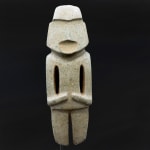Mezcala Andesite Idol, 300 BCE - 300 CE
Andesite
30.5 x 10.5 x 5.5 cm
12 x 4 1/8 x 2 1/8 in
12 x 4 1/8 x 2 1/8 in
CC.44
Further images
-
(View a larger image of thumbnail 1
)

-
(View a larger image of thumbnail 2
)

-
(View a larger image of thumbnail 3
)

-
(View a larger image of thumbnail 4
)

-
(View a larger image of thumbnail 5
)

-
(View a larger image of thumbnail 6
)

-
(View a larger image of thumbnail 7
)

-
(View a larger image of thumbnail 8
)

-
(View a larger image of thumbnail 9
)

-
(View a larger image of thumbnail 10
)

-
(View a larger image of thumbnail 11
)

The mysterious Mezcala people, noted for their production of stone figures, originated in the Guerrero region in modern Mexico. They are believed to have originated in the Middle and Late...
The mysterious Mezcala people, noted for their production of stone figures, originated in the Guerrero region in modern Mexico. They are believed to have originated in the Middle and Late Preclassical Periods of the Mesoamerican chronology (700 BC – 200 BC), and survived into the Classical Period, co-existing with the metropolis of Teotihuacan. The later Aztecs excavated Mezcala stone idols and dedicated them in their own temples, and this is how a number of these figures have come down to us. The Mezcala territory has since been denuded of artefacts, by locals hoping to sell them on the art market.
This figure has a large head, prominent brow ridge, the suggestion of nose and ears, and a large open mouth. The body is flat, with arms by its side and hands resting on the flat stomach. The broad, short, legs are splayed apart. The holes under the arms identify this piece as of the M-14 type, one of the rarer varieties of Mezcala figures. The holes are carved from both sides, and are bevelled. The reverse of the figure is flat. It is carved from an attractive blue-grey andesite, with light tan-coloured inclusions.
Some suggest that this figure may have been used as a pestle for the grinding of corn or wheat. In this understanding, the nutrition of society was associated with the phallic form of these figures. Indeed, there is a little wear on the piece, especially around the top of the head. This would seem to support this interpretation, which associates such figures with the fertility of the crop, a feature emphasised by their phallic form.
This figure has a large head, prominent brow ridge, the suggestion of nose and ears, and a large open mouth. The body is flat, with arms by its side and hands resting on the flat stomach. The broad, short, legs are splayed apart. The holes under the arms identify this piece as of the M-14 type, one of the rarer varieties of Mezcala figures. The holes are carved from both sides, and are bevelled. The reverse of the figure is flat. It is carved from an attractive blue-grey andesite, with light tan-coloured inclusions.
Some suggest that this figure may have been used as a pestle for the grinding of corn or wheat. In this understanding, the nutrition of society was associated with the phallic form of these figures. Indeed, there is a little wear on the piece, especially around the top of the head. This would seem to support this interpretation, which associates such figures with the fertility of the crop, a feature emphasised by their phallic form.










